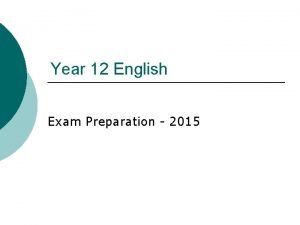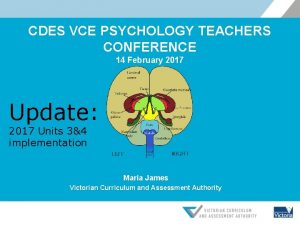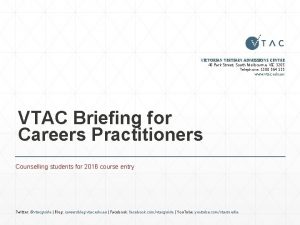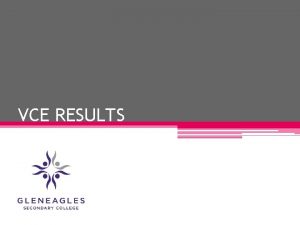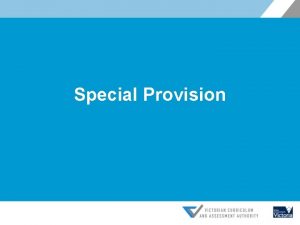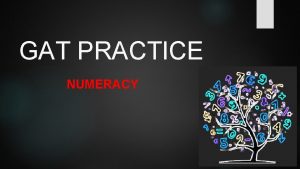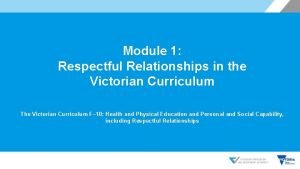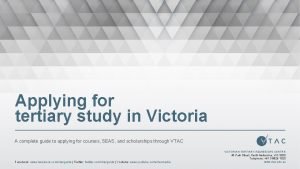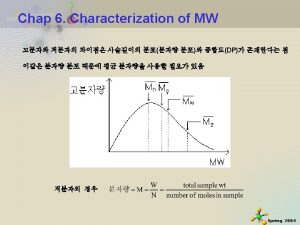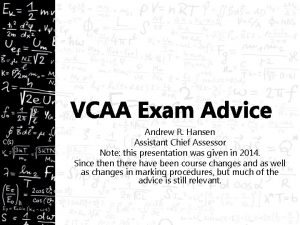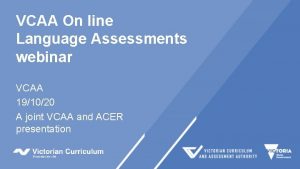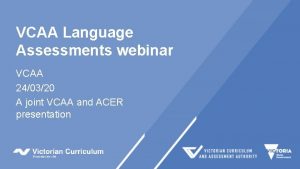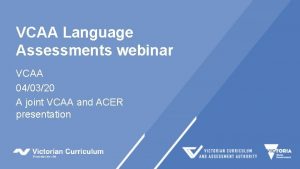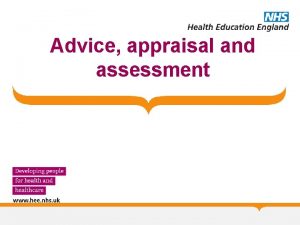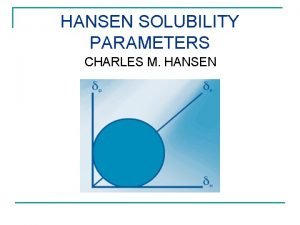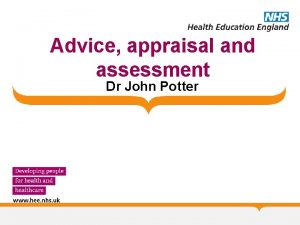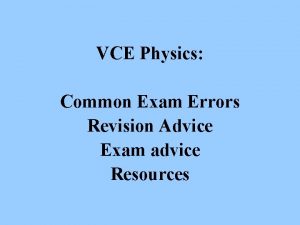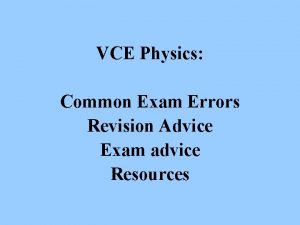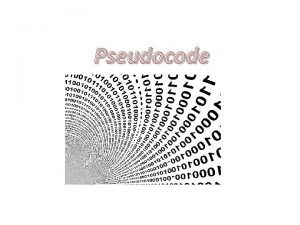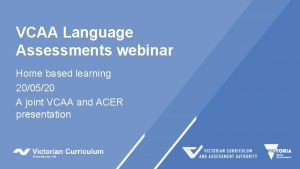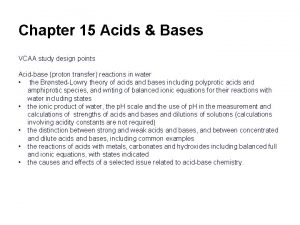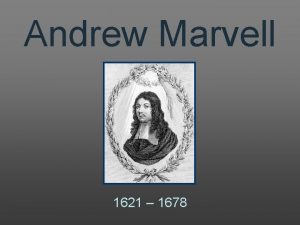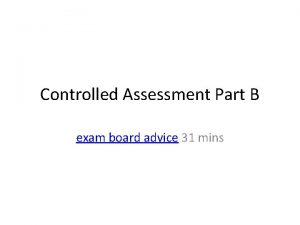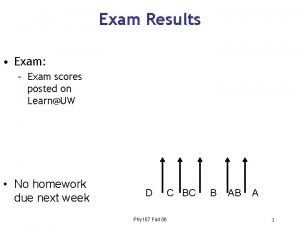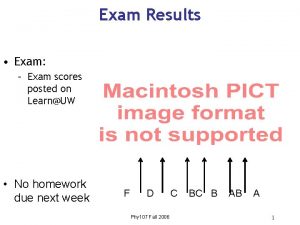VCAA Exam Advice Andrew R Hansen The Assessment

































- Slides: 33

VCAA Exam Advice Andrew R. Hansen

The Assessment Team • Chief Assessor: • Three Assistant Chief Assessors: • 10 -12 Senior markers: – Used for resolution marking • General markers: – Around 100 practicing or retired Physics teachers.

Mark allocation • In General: • 1 mark questions: – Mark for correct answer. • 2 mark questions: – 1 mark for correct answer. – 1 mark for correct formula & substitution. • 3 mark questions: – 1 mark for correct answer. – 1 mark for final formula and substitution. – 1 mark for initial derivation or conversion of info.

The marking process • Each question is marked (initially) by two markers. • Discrepancy results in a third marker. – Two most concordant results are used provided they are not still discrepant. – This marking is done by CAG and senior markers. • Marks that are still discrepant go to adjudication. – Done by CAG. • Most concordant two marks are used and added for final mark.

The marking process • Each set of scores is summed and totals that are discrepant go to 3 rd round of marking. – Done by CAG. • Final grades that differ significantly from the teacher’s indicative grades or the GAT result are declared anomalous. – Anomalous grade marking. – Done by CAG

The marking process • Papers that have images problems or where students wrote where they should not have go to pulled paper marking. – Done by CAG.

The marking process (2015) • 7211 papers and 56 “markable” items = 403, 816 items to mark. • Two initial markings = 807, 632 markings. • ~25, 000 items went to resolution @ 2 responses each = 50, 000 markings. • ~ 3000 items went to adjudication @ 1 response each = 3, 000 markings • ~ 150 papers referred to AGM = 8400 items marked.

The marking process 861, 400 + 50, 000 + 3, 000 + 8, 400 = 922, 800 With 105 markers that equates to ~8800 questions marked per marker over 10 days

v u S H t T A Now, the area under a vt graph yields disp. So: I H T S I S O N M T Finally, from (1): Sub into (3):

General advice • Always show working. – Allow markers to exercise “reward good physics” clause. – This may become mandatory in 2016. • Avoid algebraic rearrangement. – Make it easier for markers to award the “formula & substitution” mark(s). • Answers in decimals with appropriate sig figs. – No surds and no excessive decimal places.

General advice • Changing units. – Students can no longer cross out the units provided and respond in units of choice. • Layout & legibility. – Markers are not obliged to mark illegible responses. • Calculators. – Use the exponent key. – Check mode (degrees, not radians).

Short answer questions • Keep them short!!! – Stay within the space provided. • • Use dot points. Clause, because. vs. Clause. Supporting equations. Avoid verbal diarrhea. – Marks can be deducted for contradictions.

Discussion of questions from 2015 paper.

Question 5 b: Correct response

Question 5 b: Common errors involve breaking the flight up into multiple phases (launch to top, top to init height, final drop) which led to errors. Difficult for the assessors to follow.

Question 7 c: Correct response Yes. The astronauts experience apparent weightlessness as they are still in a gravitational field (w=mg), and therefore have weight, but they experience no normal reaction force (N=0).

Question 7 c: Common error A number of students said “no they would not feel weightless” and then went on to explain that they would feel “apparently weightless”. There were also a number of students who believe that weightlessness (of any kind) can only exist in a region without gravity.

Question 12 d: Correct response • Replace the commutator with slip rings. • The slip rings maintain a constant connection with the loop. • As the loop rotates an AC current will be generated in the loop which is then transmitted to the oscilloscope.

Question 12 d: Common errors The most common error was to rely on stock answers from the A 3 sheet regarding the difference between slip rings and a split ring commutator. Stock descriptions did not respond to the question being asked.

Question 13 c: Correct response • The initial flux is down and increasing. • Lenz’s Law states that the induced current will give rise to a change in flux that opposes the change that induced it. • The induced flux will be up and increasing. • The right hand grip rule shows a current from y-x in the loop will give an upwards flux. • Therefore the current will flow from x to y through the voltmeter.

Question 13 c: Common errors Marks awarded for this question varied. Most students were able to identify some of the required points but most were unable to provide a thorough response. Students should practice responding to these high scoring questions.

Question 16 f: Correct response • A real situation would be a power station supplying power to a town. • For a constant power delivery, transformers can be used to increase the transmission voltage and decrease the transmission current. • Since power loss = I 2 R, reducing the current will significantly reduce the power loss.

Question 16 f: Common errors Marks awarded for this question varied. Most students were able to identify some of the required points but most were unable to provide a thorough response. The most commonly omitted point was the need to maintain the delivered power while varying the supply parameters. Students should practice responding to these high scoring questions.

Question 21 a: Correct response • Electrons exhibit a wave behavior. • Allowed orbits are where the circumference is a whole multiple of the electron wavelength and a standing wave can be formed. • Different orbits have different whole multiples of the electron wavelength. • Orbits where the circumference is not a whole multiple of the wavelength cannot form a standing wave and are not allowed.

Question 21 a: Common errors Students had trouble linking the concept of a standing wave to the integer multiple of the electron wavelength. Students seem to think that electrons follow a sinusoidal path around the nucleus.

Reviewing practice papers • Errors come in three types: – Content knowledge gaps. – Procedural errors. – Silly mistakes.

Content knowledge gaps • Where you simple do not learn the material. • Sacrificing knowledge of some areas to focus on others. • These don’t exist.

Procedural errors • Where you have difficulty remembering how to do a type of problem. • Where you repeatedly make the same mistake even when you try to fix it. • Solution: Include worked examples of these problems on A 3 sheet.

Silly mistakes • Where you do foolish things: – Forget to square and square root. – Forget to double the time to the top. – Forget to include mg. – Forget to draw arrow heads. – The list is endless. • Solution: Include a “check for these” section on the A 3 sheet.

Preparing the A 3 sheet • You con get pre-prepared and commercial ones. I don’t. • Do not include data provided by the VCAA. – Exam covers released in Oct. • Do include derived formulae not provided by the VCAA. – Be careful here. • Do include worked examples of difficult problems.

Preparing the A 3 sheet • Do include definitions that you have trouble remembering good wording for. – Be careful using them. • Do photo-reduce things but not too small. • Do not copy things from the A 3 sheet directly onto the paper. – They won’t be worth anything.

Final words • • • Read the Chief Assessor’s Report’s. Know where the opposition is weak. Do lots of practice papers. Keep an eye on the time. Have a strategy for catching silly mistakes.

VCAA Exam Advice Andrew R. Hansen
 Vce study score bell curve
Vce study score bell curve 2015 vcaa english exam
2015 vcaa english exam Vcaa scientific poster template
Vcaa scientific poster template 2019 visual communication design exam
2019 visual communication design exam Vcaa poster template
Vcaa poster template Vce scientific poster
Vce scientific poster English language vce study design
English language vce study design Courselink vtac
Courselink vtac Vcaa theatre studies study design
Vcaa theatre studies study design Vce statement of results
Vce statement of results Extended investigation
Extended investigation Vcaa special provision
Vcaa special provision Vcaa past gats
Vcaa past gats Vcaa curriculum mapping
Vcaa curriculum mapping Eal victorian curriculum
Eal victorian curriculum Vce psychology study design
Vce psychology study design Vce media study design
Vce media study design Vce hhd study design
Vce hhd study design Vate pd
Vate pd Biology vcaa
Biology vcaa Production areas in drama
Production areas in drama Vcaa respectful relationships
Vcaa respectful relationships Vce chemistry practical investigation
Vce chemistry practical investigation Studio arts study design
Studio arts study design Music performance study design
Music performance study design Victorian curriculum progression points
Victorian curriculum progression points Vcaa audit
Vcaa audit Vtac preferences
Vtac preferences Ocr pe gcse specification
Ocr pe gcse specification Hansen dataset
Hansen dataset The tail by joyce hansen
The tail by joyce hansen Hansen solubility sphere
Hansen solubility sphere 5a morbus hansen
5a morbus hansen Beck hansen loser nomineringar
Beck hansen loser nomineringar

